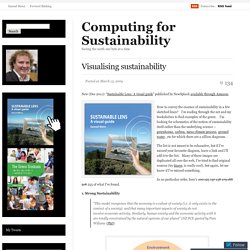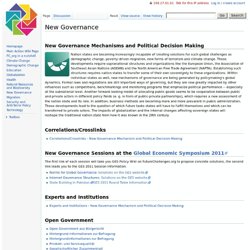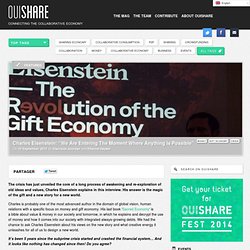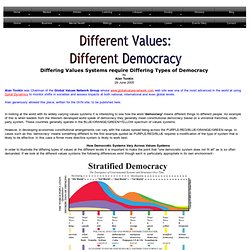

Visualising sustainability « Computing for Sustainability. New (Dec 2011): “Sustainable Lens: A visual guide” published by NewSplash available through Amazon.

How to convey the essence of sustainability in a few sketched lines? I’m wading through the net and my bookshelves to find examples of the genre. I’m looking for schematics of the notion of sustainability itself rather than the underlying science – greenhouse, carbon, meso climate process, ground water, etc for which there are a zillion diagrams. The list is not meant to be exhaustive, but if I’ve missed your favourite diagram, leave a link and I’ll add it to the list. Thirty more sustainability diagrams « Computing for Sustainability. I’m working towards structuring the collection into a book (watch this space).

I’ve almost got a framework sorted out, so this lot is filling some holes. 189 “Bretherton diagram” (based on a concept of Francis Bretherton) highlighting some of the linkages between social systems, biogeochemical systems, and the physical climate system. (NCAR) Judge_fig1.jpg (Image JPEG, 1459x710 pixels) Paradigmic-View-Concept-map-Learning-Theory.png (2726x2022) Downloadable Visual Concept Maps, Tables and Diagrams. Table-12.png (Image PNG, 2295x979 pixels) - Redimensionnée (55%) New Governance - Bertelsmann Future Challenges. From Bertelsmann Future Challenges New Governance Mechanisms and Political Decision Making Nation states are becoming increasingly incapable of creating solutions for such global challenges as demographic change, poverty-driven migration, new forms of terrorism and climate change.

These developments require supranational structures and organizations like the European Union, the Association of Southeast Asian Nations (ASEAN) and the North American Free Trade Agreement (NAFTA). Establishing such structures requires nation states to transfer some of their own sovereignty to these organizations. Within individual states as well, new mechanisms of governance are being generated by policymaking's global dynamics.
Correlations/Crosslinks New Governance Sessions at the Global Economic Symposium 2011. Correlations/Crosslinks - New Governance Mechanism and Political Decision Making - Bertelsmann Future Challenges. Government transformation framework - Ross Dawson's keynote presentationKeynote speaker. Selection of Ross Dawson Frameworks Transformation of Government Click on the image to download full size pdf.

See below for Prezi presentation of the framework including illustrative images and videos, used to support Ross Dawson’s opening keynote on the Transformation of Government at the Institute of Public Adminstration Australia annual conference. The Transformation of Government framework examines: CONTEXT Constraints Demographic trends Infrastructure demands Urbanization Climate response Energy shift Security Resource shortages Health economics TECHNOLOGY DRIVERS Exponential growth Processing power Data and storage Bandwidth Mobile bandwidth Open web SOCIAL DRIVERS Expectations Opportunity Excellence Transparency Accountability Participation GOVERNMENT LANDSCAPE ECONOMIC STRUCTURE Divergence in performance Distributed work Creative economy Cities and regions CITIZEN POWER Voices amplified Self-organization Crowdsourcing Open government.
The global power shift. The Future of Public Services; Innovations in Online Scenario Planning, Part 2. The following mini-scenarios were created using the SenseMaker Suite Scenarios approach developed for my PhD with Dave Snowden and Wendy Schultz. They were auto-aggregated using narrative fragments contributed by over 265 participants from around the world. In other words, participants submitted stories of the future, tagged them, and then the system clustered them based on affinity and representative values.
These were then boiled down into these three scenarios. From start to finish (not counting R&D experimentation, process creation, etc.) this process took a little under two weeks of effort to collect the stories, aggregate and interpret them. The Tao of Democracy - Home Page.
C. Eisenstein: "We are entering the moment where anything is possible" The crisis has just unveiled the core of a long process of awakening and re-exploration of old ideas and values, Charles Eisenstein explains in this interview.

His answer is the magic of the gift and a new story for a new world. Charles is probably one of the most advanced author in the domain of global vision, human relations with a specific focus on money and gift economy. Transhumanism's Extropy Institute - Transhumanism for a better future. Alan Tonkin - Different Values: Different Democracy. Differing Values Systems require Differing Types of Democracy byAlan Tonkin29 June 2005 Alan Tonkin was Chairman of the Global Values Network Group whose www.globalvaluesnetwork.com web site was one of the most advanced in the world at using Spiral Dynamics to monitor shifts in societies and assess impacts at both national, international and even global levels.

Disruptive innovation. Sustaining innovations are typically innovations in technology, whereas disruptive innovations cause changes to markets.

For example, the automobile was a revolutionary technological innovation, but it was not a disruptive innovation, because early automobiles were expensive luxury items that did not disrupt the market for horse-drawn vehicles. The market for transportation essentially remained intact until the debut of the lower priced Ford Model T in 1908. The mass-produced automobile was a disruptive innovation, because it changed the transportation market. Demystifying the Pattern(s) of Change: A Common Archetype « beatrice benne. We are all familiar with it because we have ridden its wave many times in our lives.

Some of us have developed the wisdom to embrace it when it arises; others are still resisting it, stricken by anxiety and fear when sensing it’s coming. Most of us, not always happily, are accepting it as an avoidable element of life. Perhaps a few have learned to enjoy it. We hate to be forced into it and we have become skilled at finding ways to turn our back to it, often in denial.
Yet, avoiding it only makes its process more difficult; it will return. Will the Global Crisis Lead to Global Transformations? 2. The Coming Epoch of New Coalitions. This article presents possible answers, and their respective probabilities, to the question, ‘What are the consequences of the present global crisis in the proximate future of the World System?’

It also attempts to describe the basic characteristics of the forthcoming ‘Epoch of New Coalitions’ and to forecast certain future conditions. Among the problems analyzed in this paper are the following: What does the weakening of the economic role of the USA as the World System centre mean? Disruptive technologies: Advances that will transform life, business, and the global economy. The relentless parade of new technologies is unfolding on many fronts.

Almost every advance is billed as a breakthrough, and the list of “next big things” grows ever longer. Not every emerging technology will alter the business or social landscape—but some truly do have the potential to disrupt the status quo, alter the way people live and work, and rearrange value pools. It is therefore critical that business and policy leaders understand which technologies will matter to them and prepare accordingly. Three trends that will create demand for an Unconditional Basic Income. Guide to 12 Disruptive Technologies. Disruptive technology is a term coined by Harvard Business School professor Clayton M. Christensen to describe a new emerging technology that unexpectedly displaces an established one. This term came out at Christensen 1997 best-selling book entitled “The Innovator’s Dilemma”. In it the author established two categories of new technologies: sustaining and disruptive. Sustaining technologies corresponds to well-known technologies that undergo successive improvements, whereas Disruptive technologies means new technologies that still lack refinement, often have performance problems, are just known to a limited public, and might not yet have a proven practical application.
Paradigm. In science and philosophy, a paradigm /ˈpærədaɪm/ is a distinct set of concepts or thought patterns, including theories, research methods, postulates, and standards for what constitutes legitimate contributions to a field. Etymology[edit] Paradigm comes from Greek παράδειγμα (paradeigma), "pattern, example, sample"[1] from the verb παραδείκνυμι (paradeiknumi), "exhibit, represent, expose"[2] and that from παρά (para), "beside, beyond"[3] and δείκνυμι (deiknumi), "to show, to point out".[4]
Main Page - Metagovernment - Government of, by, and for all the people. A Rupture With The Past. This is the end of the world as we’ve known it. But it isn’t the end of the world Kurt Andersen, Time, 6 avril 2009, p. 35. A society is rupturing when the volume and complexity of its activities changes to the point where its statistics become exponential. Constellation W. Paradigm shift. A paradigm shift (or revolutionary science) is, according to Thomas Kuhn, in his influential book The Structure of Scientific Revolutions (1962), a change in the basic assumptions, or paradigms, within the ruling theory of science. It is in contrast to his idea of normal science. Metasystem transition. A metasystem transition is the emergence, through evolution, of a higher level of organization or control. Transformative Studies Institute. Synergetics (Fuller) Math explains history: Simulation accurately captures the evolution of ancient complex societies.
Collapse dynamics: Phase transitions in complex social systems. Great Transition Initiative. Value Network. Community of Practice. How the System Works (or doesn't) 8 No Time Left. Now Journal. Ed. Emergence.
The Misfit Economy. Transition Network. Gender spenders. Many Americans went into personal debt before the economic recession hit the country in 2008. Nurturing the emergence of a thrivable future. The Next Edge. Sustainable Practice 1. The disruptive power of collaboration: An interview with Clay Shirky. A Strategic Opening for a Basic Income Guarantee in the Global Crisis Being Created by AI, Robots, Desktop Manufacturing and BioMedicine. James J. Hughes Institute for Ethics and Emerging Technologies Trinity College, Hartford CTjames.hughes@trincoll.edu Journal of Evolution and Technology - Vol. 24 Issue 1 – February 2014 - pgs 45-61 Abstract. Robert Reich: Raising Taxes on Corporations That Pay Their CEOs Royally and Treat Their Workers Like Serfs. Futurable Planet: Answers from a Shifted Paradigm.